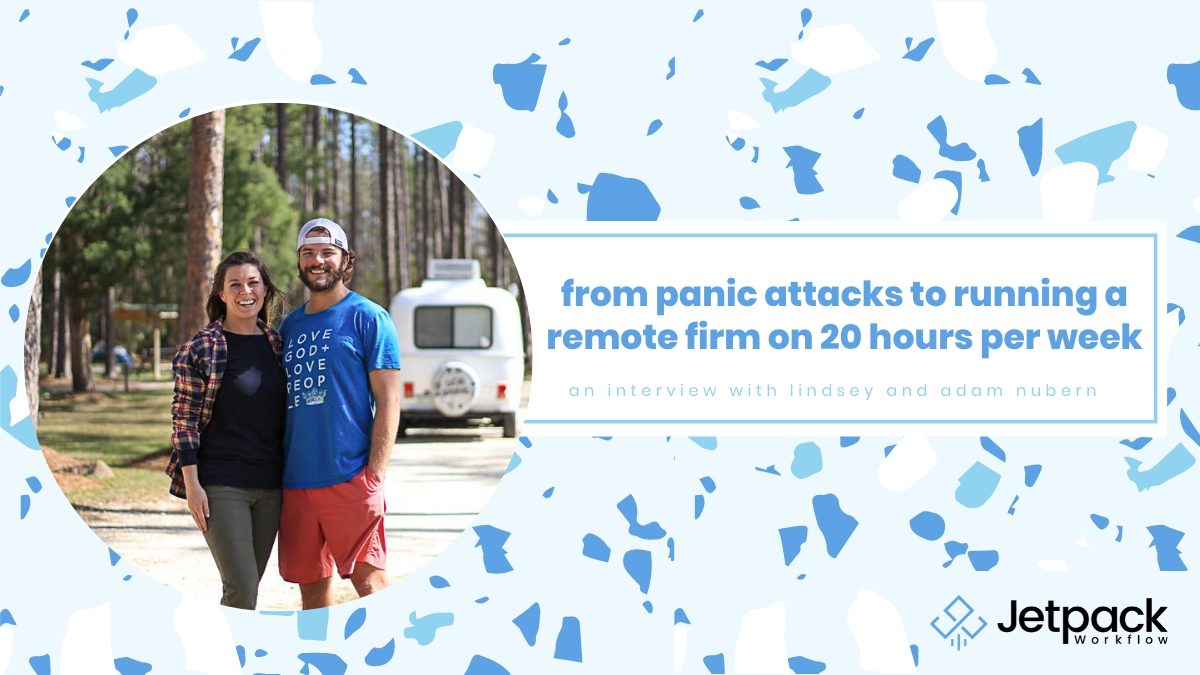From Panic Attacks to Running a Remote Firm on 20 hours Per Week

While many of us have been working remotely for the past few months, not all of us have experienced remote work in our own terms. Long before the stay at home mandate, there was a magical group of individuals who chose to work remotely, from anywhere in the world. These digital nomads are people who work with just a laptop and travel the world on their own terms while doing it. It’s a dream for many professionals, and it’s completely possible for entrepreneurs who have the personal flexibility to live abroad. But to do it right, you need to have exceptional workflows in place to avoid distraction and to minimize time spent in front of the computer.
Today’s podcast is a special episode with Lindsey and Adam Nubern from Nuventure CPA. As digital nomads, they use their expertise while working remotely to serve their similarly on-the-go clients. Our gracious guests also shared how they scaled and built the right processes for their firm.
Summary
- Nuventure CPA Beginnings
- Niched And Scaled Small
- The Business Owner Trap
- Pricing
- Connecting with Clients
- Invoices
- The Power of Subtraction in Processes
Resources
- 3x Your Clientele with One Sentence
- How Workflow Improvements Helped This Firm 2X Clients and 3X Revenues!
- How to Attract Top Talent with Your Job Posting
Nuventure CPA Beginnings
Niched and Scaled Small
Lindsey and Adam Newbern are the founders of Nuventure CPA, and they have uniquely organized their business. While many CPA firms strive to grow large, with a large staff, a massive customer base, and sizable profits, Nuventure CPA is built quite differently.
Lindsey and Adam are a married couple who are adventurers, and shortly after college, they decided that they wanted to make enough money to live the lifestyle they desired. As a result, they also made a conscious decision to keep their firm small with only three people: Lindsey, Adam, and a bookkeeper. With a small staff, it is important for CPA firms following this model to be choosy about who they onboard, and this requires creating strategic job postings.
With a very specific customer, a specific client, and a specific outcome, Nuventure CPA operated according to the terms and lifestyle that Lindsey and Adam enjoy. Being travelers themselves, their niche customers are clients who are also digital nomads with tricky tax questions stemming from their mobility. For those who are interested in adapting to a remote model of operations, Lindsey and Adam are definitely powerful resources!
The Business Owner’s Trap
With the business having few staff members, Adam was put in a tricky position of having to both manage the business operations and provide promised services to clients. There were several tensions between handling the administrative requirements of running and owning a business and being caught up with the technical requirements of the services being offered.
Some traps that Lindsey and Adam have had to resolve include pricing, communications with clients, client retention, and business processes. Lindsey and Adam offer us details of the pain points they noticed, and how they created solutions to overcome those problems.
Pricing
In the beginning, Adam charged $40 per hour as a bookkeeper and consultant. In 2015, he researched the average rates and tried to meet those rates. He was short-changing himself, having mentally mislabeled his services as “average.”
Now he charges $175 per hour for consulting projects. For individual returns, he charges a minimum of $500, which include filing a 1040-A and an itemized Schedule A or a Schedule C. For S corporations, he charges a minimum of $770, and for partnerships, he charges a minimum of $735.
As prices increased, the customer service increased in importance and value. When Lindsey came onboard to help Adam with the workload, she noticed several ways to enhance the value of the services Adam was providing.
Communications
Lindsey and Adam were noticing a couple of clients were leaving for other accountants who offered year-round communication. In contrast, Adam was only communicating with them during the tax season.
Lindsey’s role was to manage communications throughout the year. Some of her communications included reminding people to make their quarterly estimated payments and offering tips on how to save money on their taxes. As she continued handling the communications of the business, she noticed a lot of inefficiencies. Typically, new business owners assume that such inefficiencies and problems result in only business-related issues.
In their case, the time spent inefficiently in business was taking away from Lindsey’s and Adam’s freedom as a family.
One of the first issues Lindsey noticed was that Adam was spending a lot of time communicating with his clients through a contact form. Prospective clients found him on his website and sent a contact form to him. He would then take the time of emailing them his Calendly link, waiting for them to respond.
To simplify this process, Lindsey and Adam removed email altogether by removing the contact form from his website. Instead, they replaced the contact form with Calendly so prospective clients can easily book a 20-minute appointment with Adam.
A simple change in processes cleared up extra time for Adam to complete other tasks. This would be a theme that both Lindsey and Adam noted: there are easier, more time-efficient ways to accomplish tasks without the headache.
Invoicing and Automation
Another duty Adam was taking a lot of time to complete was invoicing. At one point, Adam would spend up to a full day working on invoices. It wasn’t until a friend in financial planning came to his rescue to give a wake-up call: spending an entire day on invoices alone is not necessary.
His friend had a side job creating automation, and he presented a solution to Adam’s invoicing problem. Since that incident, both Lindsey and Adam have been actively keeping their eyes open for any opportunities to automate their tasks. For example, Lindsey learned how to create templates in Google to answer the client’s frequently asked questions.
All tasks consume time, and automating can be a serious game-changer in not only improving how you manage your clients but also your time. Afterall, an increase in client satisfaction brings more clients and revenues. So it is always worthwhile to consider how to increase the efficiency of your business processes.
The Power of Subtraction in Processes
Often when CPA firms seek to enhance their workflow, they think they must add apps to their tech stack with more bells and whistles. However, Lindsey and Adam have proven that the key is not the number of apps or processes but the quality.
Instead of adding extra steps to a process or adding extra apps, it may be prudent to downsize and decrease the steps: flex the power of downsizing processes. It’s difficult to start, but it is critical to design elegant systems that require elimination.
Want to know more about how Lindsey and Adam further enhanced their processes? Check out the full episode! You can reach Lindsey and Adam at https://www.nuventurecpa.com/, or see follow along with their travels at https://nuventuretravels.com/.





